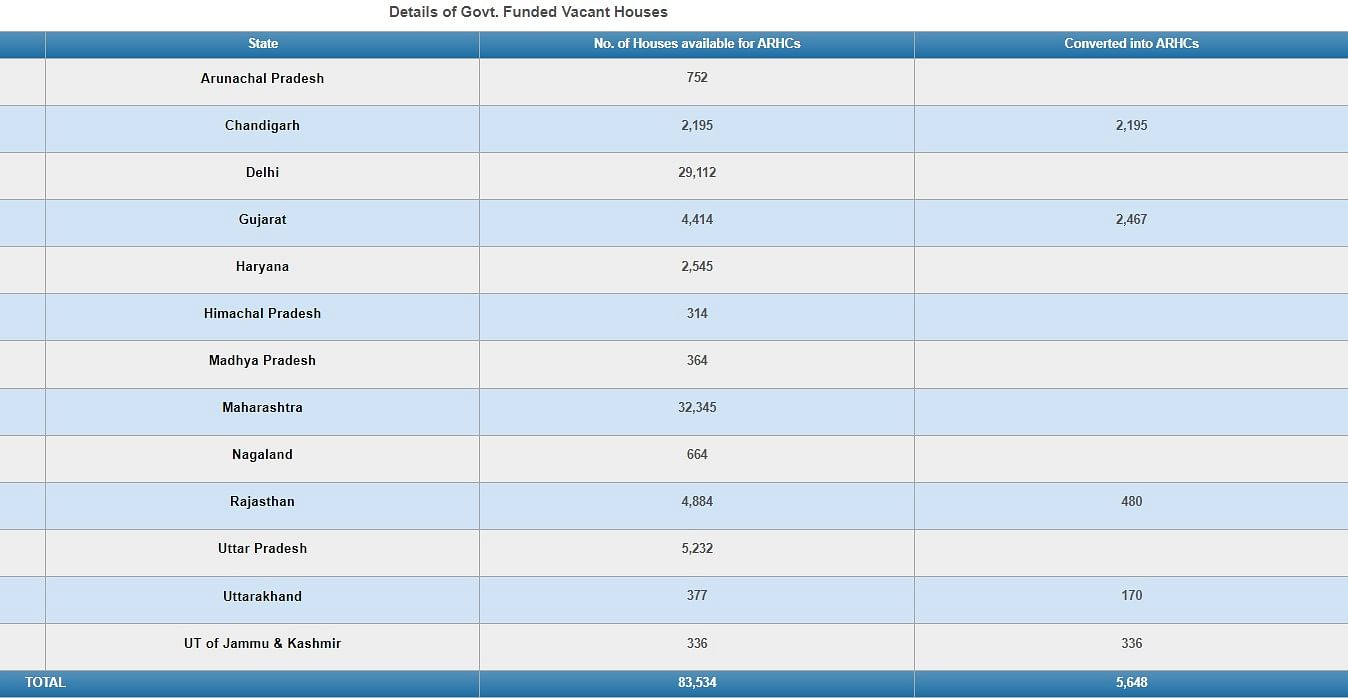The ARHC scheme aims to create a sustainable ecosystem of cost-effective rental housing for economically weaker sections (EWS) and low-income groups and achieving the overall objective of ‘Housing for All.’
The Affordable Rental Housing Scheme (ARHC) has successfully transformed a total of 5,648 vacant houses built under various government schemes previously, into affordable rental complexes.
These units will be provided to the beneficiaries under the Pradhan Mantri Awas Yojana-Urban (PMAY-U).
The Ministry of Housing and Urban Affairs (MoHUA) initiated the ARHC as a sub-scheme of PMAY during the COVID-19 pandemic with the objective to provide secured housing facilities to migrant workers and urban poor — employed in hospitality sectors, health institutions, industrial workers and also in the informal sectors.

(Source: MoHUA, March 2023)
The Urban Development Ministry informed the Rajya Sabha on 27 March that 5,648 vacant houses had been converted into ARHCs in Chandigarh, Gujarat, Rajasthan, Uttarakhand, and Jammu and Kashmir.
Out of these, 4,470 houses have already been occupied by beneficiaries. Moreover, a request for proposal has been issued for 7,413 vacant houses in various other states, reports The Hindu.
The Ministry has further authorised construction of 82,273 new units under the scheme in the public-private partnership (PPP) model.
Another 7,413 vacant houses have been identified to be converted under the ARHC scheme.
Urban regions tend to attract seasonal urban migrants who are mainly employed in the construction and industrial sectors.
These areas often have a high concentration of demand for housing resources, particularly rental housing for seasonal migrants.
The ARHC scheme aims to create a sustainable ecosystem of cost-effective rental housing for economically weaker sections (EWS) and low-income groups and achieving the overall objective of ‘Housing for All.’
Operational guidelines for the scheme were issued in July 2020, under which the government has ensured special provisions — such as 50 per cent additional Floor Space Index (FSI), single window clearance, relaxation in existing rent control laws — in order to promote the development of rental housing complexes.
The Scheme Is Formulated Through Two Models
Under Model 1, the government is going to utilise existing vacant houses to be converted for rental housing.
These includes existing government funded vacant houses constructed under the Jawaharlal Nehru National Urban Renewal Mission (JNNURM) and Rajiv Awas Yojana (RAY).
In Model 2, the construction and operations of affordable rental housing complexes will be executed by public and private entities on their own available vacant lands.
The organisations responsible for building the housing units and dormitories have taken steps to protect the housing rights of the targeted population.
These initiatives ensure that the basic amenities necessary for decent living conditions are provided. The operational tenure has been intended for a minimum of 25 years.
The scheme also provides guidelines with specific details of the developed units. The complex will have single bedroom and double bedroom units, of sizes 30 sq-m and 60 sq-m, respectively.
The dormitories to be developed should have halls to accommodate four to six beds.
Furthermore, under Model 2 of the scheme, 73 proposals had been received from public or private entities for the construction of 1,39,471 units in 18 states and Union Territories, as per The Hindu report.
Out of this, 13 proposals for constructing 82,273 new ARHC units in seven states have been approved by the Ministry. (Read more on Model-2 of ARHC)


